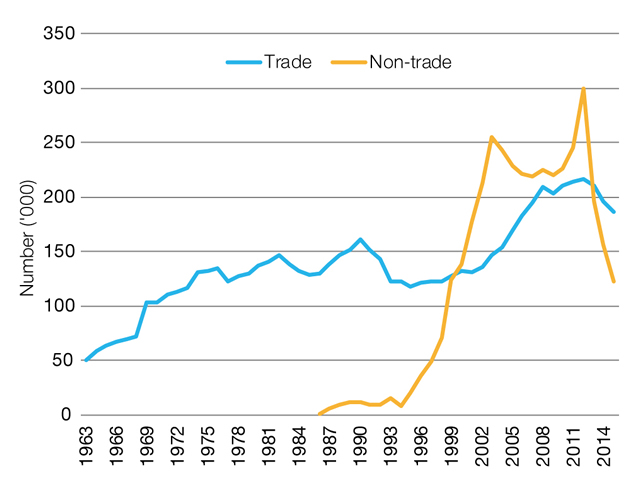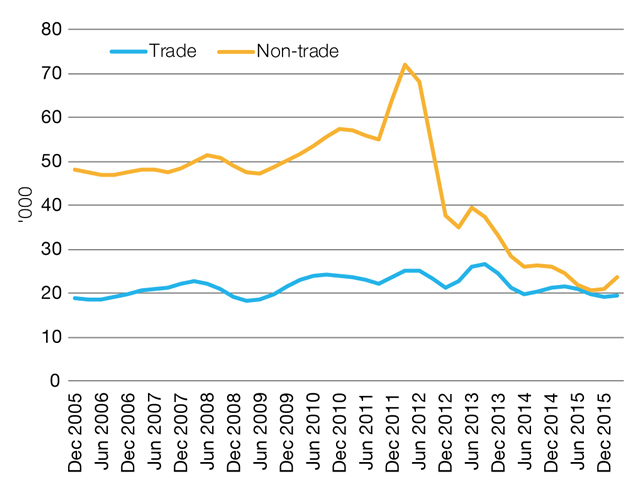Geoff Gilfillan, Statistics
and Mapping
Key Issue
Apprenticeship and traineeship numbers have been falling since mid‑2012. However, the major falls have occurred in non‑trade occupation traineeships.
Declining numbers of commencements could be driven by changes to incentive payments made in mid‑2012; the decline in demand for skills associated with a softening labour market, and the uncapping of university placements.
Trade and non‑trade apprenticeship and
traineeship numbers have been falling in Australia since the middle of 2012. Data
from the National Centre for Vocational Education Research (NCVER) shows there
were 291,000 apprentices and trainees in training in December 2015 (in
seasonally adjusted terms)— down on the most recent peak of 490,000 in June
2012.
When separated out over the longer term, it is
evident that apprentices and trainees in non‑trade occupations have
fallen dramatically from their peak of 300,000 in June 2012 to 104,000 in December
2015.
Non‑trade occupations for trainees include farm
managers, sales workers, clerical and administrative workers, community and
personal service workers and drivers and machine operators.
The fall in the number of apprentices and trainees
in trade occupations during the same interval is significant but not as
dramatic—down from 216,600 to 175,000.
Figure 1 shows long‑term trends in trade and
non‑trade apprentices and trainees by calendar year.
Figure 1: Trade and non-trade apprentices
and trainees in‑training

Source: NCVER, Apprentices
and trainees 2015 December quarter, NCVER, 2016, Table 1, original data.
One of the reasons for the decline in non‑trade
occupation commencements was the change
in incentive payments offered by the Federal Government which took effect
from 1 July 2012. The changes included:
- the discontinuation of the $1,500 standard employer commencement
incentive payment and
- an increase in the standard completion incentive from $2,500 to $3,000
for existing worker apprentices and trainees in non‑National Skills Needs
List occupations.
The fall in apprenticeship and traineeship numbers
since mid‑2012 may also be a reflection of reduced demand for labour in
particular industries. In this period the mining industry and utilities have
been shedding labour while manufacturing has been in long term decline. Demand
for skilled trades has been strongest in construction.
Trade based occupation commencements for
apprentices have been relatively consistent over the past decade despite the
impact of events such as the Global Financial Crisis (GFC) between 2007 and
2009. In contrast, non‑trade occupation commencements have fallen
substantially since mid‑2012.
Figure 2: Trade and non‑trade apprentice
and trainee commencements

Source: NCVER, Apprentices
and trainees 2015 December quarter, NCVER, 2016, Table 21, Seasonally
Adjusted data.
The changes appear to have proportionally the greatest affect
on women and older apprentices and trainees. Female apprentices and trainee
numbers have fallen by 112,000 or 59% between June 2012 and December 2015,
compared with a fall of 125,500 or 38% for men.
Over the same period, the number of apprentices and
trainees aged 45 years and over fell by 57,000 or 71% while those aged 25 to 44
years fell by 95,600 or 55%. In comparison, apprenticeships and traineeships
for people aged 19 years and under and 20 to 24 years fell by 39% and 26% respectively.
Of the trade occupations, the largest falls were
recorded for engineering, information and communications technology (ICT), and
science technicians (down 58%); and automotive and engineering trade workers
(down 24%).
Some of the building trades have been less
affected. The numbers of apprentice bricklayers, carpenters and joiners in
training have only fallen marginally (by 5%) while plumbers fell by 3%. However,
electricians in training have fallen by 10%. The only occupation to record a
rise in apprenticeships was electronics and telecommunications trade workers (up
27%).
In a recent newspaper
article the NCVER suggested that declining apprenticeship numbers could partly
be due to the uncapping of university places. The Australian
Industry Group expressed concern at the prospect of skill
shortages in the future from declining apprentice and trainee commencements.
Current evidence of shortages in skilled
occupations is mixed, with a general decline in demand for skilled labour since
the GFC contributing to more skilled occupations being in balance rather than
shortage. Analysis conducted by the Department of Employment showed just over
40% of trade and technician occupations were in shortage in 2014‑15
compared with 97% in 2007–08.
Further reading
NCVER, Apprentices and trainees 2015 December quarter, NCVER, 2016.
Department of Employment,
Skill shortages—statistical summary, Department of Employment, Canberra, 2015.
Back to Parliamentary Library Briefing Book
For copyright reasons some linked items are only available to members of Parliament.
© Commonwealth of Australia

Creative Commons
With the exception of the Commonwealth Coat of Arms, and to the extent that copyright subsists in a third party, this publication, its logo and front page design are licensed under a Creative Commons Attribution-NonCommercial-NoDerivs 3.0 Australia licence.